| |
|
Xiamen Oil Paintings, Wholesale Direct!
|
|
100% hand painted, 100% cotton canvas, 100% money back if not satisfaction. |
|
|
|
|
ART WORKS INDEX
A
B
C
D
E
F
G
H
I
J
K
L
M
N
O
P
Q
R
S
T
U
V
W
X
Y
Z
|
|
ARTISTS INDEX
A
B
C
D
E
F
G
H
I
J
K
L
M
N
O
P
Q
R
S
T
U
V
W
X
Y
Z
|
|
|
|
 |
ZIMMERMANN, Dominikus
|
|
German sculptor, Bavarian school (b. 1685, Wessobrunn, d. 1766, Wies)..Architect, stuccoist and painter, brother of (1) Johann Baptist Zimmermann. For the first two decades of his creative life, from about 1705, he worked mainly as a builder of altars and as a marbler. His most important commission came from the Benedictine abbey of Fischingen (Thurgau), for which he made six artificial marble altars with scagliola inlays (1708-9). Similar altars, mainly in Swabia, are attributed to him or known to be his work; their construction shows the influence of Johann Jakob Herkommer, with whose work Dominikus became familiar while living in F?ssen (1708-16). Between 1709 and 1713 he worked with (1) Johann Baptist Zimmermann at the Buxheim Charterhouse (see above), producing artificial marble altars and stuccowork that is characterized by the botanical accuracy of the plant motifs.
|
|
 |
ZIMMERMANN Dominikus
|
|
German sculptor, Bavarian school (b. 1685, Wessobrunn, d. 1766, Wies)
German sculptor, Bavarian school (b. 1685, Wessobrunn, d. 1766, Wies)Architect, stuccoist and painter, brother of Johann Baptist Zimmermann. For the first two decades of his creative life, from about 1705, he worked mainly as a builder of altars and as a marbler. His most important commission came from the Benedictine abbey of Fischingen (Thurgau), for which he made six artificial marble altars with scagliola inlays (1708-9). Similar altars, mainly in Swabia, are attributed to him or known to be his work; their construction shows the influence of Johann Jakob Herkommer, with whose work Dominikus became familiar while living in Fessen (1708-16). Between 1709 and 1713 he worked with Johann Baptist Zimmermann at the Buxheim Charterhouse, producing artificial marble altars and stuccowork that is characterized by the botanical accuracy of the plant motifs.
|
|
|
|
|
|
|
|
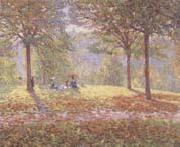 |
Wynford Dewhurst
|
|
British, 1864-1941
Wynford Dewhurst was born in Manchester in 1864. He was educated at home by a private tutor and later at Mintholme College. Although he originally trained to enter the legal profession, he showed artistic flair and decided to pursue a career as a painter after some of his drawings were published in various journals.
He gained his artistic training in France at the Ecole des Beaux-Arts, in Paris, where he was a pupil of the renowned French painter Jean-L??on Gerome. Despite his teacher Gerome rejection of the radical Impressionist movement in favour of a highly finished academic style (Gerome continued the development and conservation of French Neoclassicism), Dewhurst was heavily influenced by the Impressionists. It is well known that he first encountered Impressionism, to which he was instantly attracted, in the work of Emile Claus in the Maddocks Collection in Bradford. However his most important mentor would become Claude Monet.
It was Monet to whom Dewhurst dedicated his pioneering account of French Impressionism, Impressionist Painting: its genesis and development, in 1904. This was the first important study of the French painters to be published in English. As well as helping to reintroduce British artists to this style of painting, Dewhurst book called attention to the French Impressionists debt to the British artists John Constable and J. M. W. Turner, claiming that the Impressionists simply developed their existing painterly techniques. According to Dewhurst, artists who, like himself, painted in an impressionist manner, were often sneered at for imitating a foreign style, and he was keen to justify their position. French artists simply developed a style which was British in its conception, he wrote, a view that was dismissed by some French painters - such as Pissarro - who revealed his national bias when he acknowledged Constable and Turner but identified instead French influences like Nicolas Poussin, Claude Lorrain, Jean-Baptiste-Sim??on Chardin and Jean-Baptiste-Camille Corot. The thesis that Dewhurst put forward in Impressionist Painting was controversial for it dealt with the debated question of whether Impressionism was French or British in origin. However, it found much support in Britain: Kevin McConkey informs us that Dewhurst theme was taken up by others as various as Clausen, John Rothenstein and Kenneth Clark Nevertheless, Dewhurst detailed biographical notices of the most prominent artists associated with the rise of impressionism in France...leave little to be desired from the historical point of view. It is worth noting that Impressionist Painting also included an entire chapter on female artists, since modernity is the note of Impressionism, and that movement was the very first artistic revolt in which women took part. Indeed, Dewhurst thanks the celebrated female painter Mary Cassatt (who worked within the Impressionist circle) for her assistance in the preface of his book.
|
|
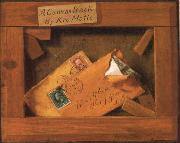 |
William Morris Davis
|
|
February 12, 1850 - February 5, 1934,Davis, who was born in Philadelphia, Pennsylvania, was educated at Harvard. He returned to teach there in 1877 after a period as a meteorologist in Argentina and as an assistant with the North Pacific Survey. He became professor of physical geography in 1890 and of geology in 1898. Davis is acknowledged as the founder of geomorphology, the study of landforms. In his The Rivers and Valleys of Pennsylvania (1889) he first introduced what later became known as the Davisian systems of landscape analysis. His aim was to provide an explanatory description of how landforms change in an ideal situation and his most important contribution to this was his introduction of the cycle of erosion into geographical thought. He proposed a complete cycle of youth, maturity, and old age to describe the evolution of a landscape. In youth rivers occupy steep V-shaped valleys while in old age the valleys are broad. The end product would be a flat featureless plain he called a epeneplaine. This was an ideal cycle but in practice the cycle would invariably be interrupted by Earth movements. It was, nevertheless, strongly attacked by German geographers who objected to it on the grounds that it neglected such vital factors as weathering and climate in transforming the landscape. They also believed him to be undermining their argument that landforms could only be discovered by local fieldwork and the production of regional monographs. Davis also produced an influential work,
|
|
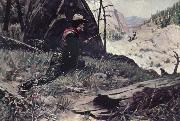 |
William Herbert Dunton
|
|
a self-taught artist . American Painter , 1878-1936
was an American artist who was one of the founding members of the Taos Society of Artists and part of the Taos art colony. He first came to Taos, New Mexico, in 1912. Among his proteges in Western art was Harold Dow Bugbee of Clarendon and Canyon in the Texas Panhandle.
|
|
|
|
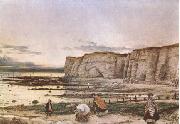 |
William Dyce
|
|
1806-1864
Scottish painter, educationalist, theorist and designer. The son of a lecturer in medicine at Marischal College, Aberdeen, he studied medicine and theology, obtaining his Master's degree in 1823. Episcopalian by upbringing, Dyce was expected, like his cousin, the scholar and bibliophile Alexander Dyce (1798-1869), to proceed to Oxford to take orders. His early interest in art found an outlet in portraiture, his first commission being Sir James M. D. M'Grigor (1823; U. Aberdeen). His first attempt at history painting, The Infant Hercules Strangling the Serpents sent by Juno to Destroy Him (1824; Edinburgh, N.G.), much influenced by Reynolds, was shown to Sir Thomas Lawrence, who is said to have encouraged Dyce to enter the Royal Academy Schools in 1825. After a few months he set off for Rome in the company of Alexander Day;
|
|
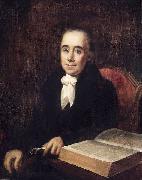 |
William Dunlap
|
|
(1 February 1766 - 28 September 1839) was a pioneer of the American theater. He was a producer, playwright, and actor, as well as a historian. He managed two of New York's earliest and most prominent theaters, the John Street Theatre (from 1796?C98) and the Park Theatre (from 1798?C1805). He was also an artist, despite losing an eye in childhood.
He was born in Perth Amboy New Jersey, the son of an army officer wounded at the Battle of Quebec in 1759. In 1783, he produced a portrait of George Washington, now owned by the United States Senate, and later studied art under Benjamin West in London. After returning to America in 1787, he worked exclusively in the theater for 18 years, resuming painting out of economic necessity in 1805. By 1817, he was a full-time painter.
In his lifetime he produced more than sixty plays, most of which were adaptations or translations from French or German works. A few were original: these were based on American themes and had American characters. However, he is best known for his encyclopedic three-volume History of the Rise and Progress of the Arts of Design in the United States, which was published in 1834, and which is now an invaluable source of information about artists, collecting, and artistic life generally in the colonial and federal periods.
|
|
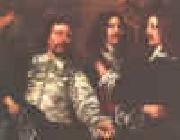 |
William Dobson
|
|
1610-1646
English
William Dobson Locations
William Dobson (March 4, 1610 ?C October 28, 1646) was a portraitist and one of the first notable English painters, praised by his contemporary John Aubrey as the most excellent painter that England has yet bred.
Dobson was born in London the son of a decorative artist, and was apprenticed to William Peake and probably later joined the studio of Francis Cleyn. He is believed to have had access to the Royal Collection and to have copied works by Titian and Anthony Van Dyck, King Charles I chief painter. The colour and texture of Dobson work was influenced by Venetian art, but Van Dyck style has little apparent influence on Dobson. Van Dyck himself discovered Dobson when he noticed one of the young artists pictures in a London shop window. He introduced Dobson to the King, who had Dobson paint himself, his sons and members of the court.
When Van Dyck died in 1641, Dobson probably succeeded him as sergeant-painter to the King, though proof is lacking. During the English Civil War Dobson was based at the Royalist centre of Oxford and painted many leading Cavaliers. His portrait of the future Charles II as Prince of Wales at the age of around twelve is a notable baroque composition, and perhaps his finest work. He also painted the Duke of York, Prince Rupert of the Rhine and Prince Maurice.
Charles II when Prince of Wales, circa 1642 or 1643.Around sixty of Dobson works survive, mostly half-length portraits most of them dated from 1642 or later. The thick impasto of his early work gave way to a mere skim of paint, perhaps reflecting a wartime scarcity of materials. After Oxford fell to the Parliamentarians, in June 1646, Dobson returned to London. Now without patronage, he was briefly imprisoned for debt and died in poverty at the age of thirty-six.
Dobson is regarded as a talented painter with a fine sense for colour and good powers of observation. However, an entirely English training such as Dobson could not be first rate in the early 17th century and he had technical weaknesses[citation needed]. There are examples of Dobson work at Tate Britain and the National Portrait Gallery in London and at several English country houses. The most comprehensive study of Dobson and his work is William Dobson, 1611?C1646 an exhibition catalogue written by M. Rogers for a 1983 exhibition at the National Portrait Gallery.
|
|
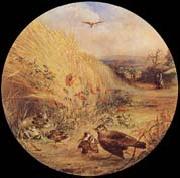 |
William Dexter
|
|
Australian, 1818-1860,was an English-Australian painter. Dexter was born at Melbourne, Derbyshire, England, and became an apprentice at the Derby China factory painting flowers and birds in the Chinese and Japanese styles. Dexter then studied at Paris, and returning to England, married Caroline nee Harper at Nottingham in 1843. Dexter had a picture in the Royal Academy exhibition in 1851 and another in 1852. Dexter then sailed to Australia and arrived at Sydney on 8 October 1852. Dexter was at Bendigo in August 1853, where William Howitt heard him advocating republican doctrines at a meeting of diggers. His wife came out from England at the end of 1854, and in March 1855 they together opened a gallery of arts and school of design in Bathurst Street, Sydney. This apparently was not a success for they went to live at Stratford, Victoria, in 1856, and there made the acquaintance of Angus McMillan. In 1857 Dexter exhibited six oils and three watercolours at the first Victorian Society of Fine Arts exhibition, held in Melbourne. Soon afterwards he returned to Sydney as the Dexters had separated. He became a partner in a sign-writing business, dying there in 1860.
|
|
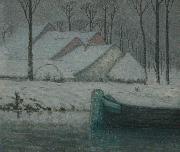 |
William Degouwe de Nuncques
|
|
(28 February 1867 - 1 March 1935) was a Belgian painter.
He was born at Montherme, the Ardennes, France, of an old aristocratic family, After the Franco-Prussian war (1870-71), his parents settled in Belgium, and he taught himself to paint. In 1894 he married fellow artist Juliette Massin, who introduced him to the circle of Symbolist poets, who had a considerable influence on his style. He belonged to the avant-garde group Les XX and later exhibited at La Libre Esthetique. He travelled widely and painted views of Italy, Austria and France, often of parks at night. His best-known pictures, Pink House (1892), The Angels (1894), and Peacocks (1896), demonstrate the magical quality of his work. Pink House is thought to have been a major influence on Surrealism, especially the paintings of Rene Magritte.
He is supposed to have said "To make a painting, all you need to do is to take some paints, draw some lines, and fill the rest up with feelings." A regular exhibitor in Paris, he was championed by Puvis de Chavannes and Maurice Denis.
From 1900 to 1902 he and his wife lived in the Balearic Islands, where he painted the rugged coastline and the orange groves. After suffering a religious crisis around 1910, he painted pictures that revealed his tormented state of mind, and during World War I, while a refugee in the Netherlands, he produced only minor works. In 1919 he was overwhelmed by the death of his wife and lost the use of one hand. In 1930 he married the woman who had helped him through the crisis. They settled in Stavelot, where he spent his last few years painting snow-covered landscapes.
The best collection of his paintings is in the Kröller-Meller Museum, Otterlo.
|
|
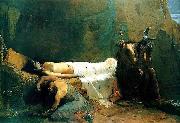 |
William de Leftwich Dodge
|
|
(1867-1935) was an American artist best known for his murals, which were commissioned for both public and private buildings.
Dodge was born at Liberty, Virginia in the Piedmont near Lynchburg. In 1879, his mother, Mary de Leftwich Dodge, an aspiring artist, moved her family to Europe. After living initially in Munich they moved to Paris, where she worked on art. Dodge later followed her example and became an artist. He spent most of his childhood years in France, where his mother was working on art. He studied at the École des Beaux Arts and took first place in the examinations in 1881. He also studied under Jean-Leon Gerôme and with Raphaël Collin at the Academie Colarossi,[1] and traveled to Munich for studies there.
|
|
|
|
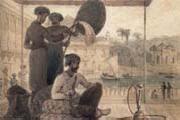 |
William Daniell
|
|
English, 1769-1837, was a British draughtsman. Castle Broichin on the Isle of Raasay. 1819 aquatint by William DaniellDaniell was fourteen when he accompanied his uncle Thomas Daniell to India
|
|
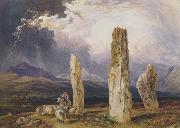 |
William Andrews Nesfield
|
|
British Painter, 1793-1881
was born in Lumley Park, County Durham. In 1808, after the death of William's mother, the family moved the few miles to Brancepeth where his father became rector of St Brandon's Church. His stepmother was Marianne Mills of Willington Hall, whose nephew was the noted architect Anthony Salvin. William's younger sister in fact married Salvin. Nesfield was educated at Durham School, then located on Palace Green, before entering the army. He fought under Wellington in Spain and at Waterloo and also served for two years in Canada. He retired in 1816 and took up a career as a painter of watercolours, particularly of waterfalls, earning the praise of John Ruskin in Modern Painters. While still exhibiting at the Old Water Colour Society, Nesfield began work as a professional landscape architect, with the encouragement of Salvin. From 1840 until his death he was responsible, either singly or with his sons Arthur Markham and William Eden for no fewer than 259 commissions in the British Isles.
|
|
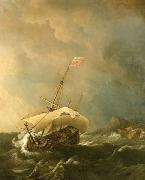 |
Willem Van de Velde The Younger
|
|
(bapt. 18 December 1633 - 6 April 1707) was a Dutch marine painter.
Willem van de Velde was baptised on 18 December 1633 in Leiden, Holland, Dutch Republic.
A son of Willem van de Velde the Elder, also a painter of sea-pieces, Willem van de Velde, the younger, was instructed by his father, and afterwards by Simon de Vlieger, a marine painter of repute at the time, and had achieved great celebrity by his art before he came to London. In 1673 he moved to England, where he was engaged by Charles II, at a salary of £100, to aid his father in "taking and making draughts of sea-fights", his part of the work being to reproduce in color the drawings of the elder van de Velde. He was also patronized by the Duke of York and by various members of the nobility.
He died on 6 April 1707 in London, England.
|
|
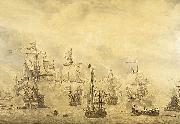 |
Willem van de Velde the Elder
|
|
(c. 1611 - 13 December 1693) was a Dutch Golden Age seascape painter.
Willem van de Velde, known as the Elder, a marine draughtsman and painter, was born in Leiden, the son of a Flemish skipper, Willem Willemsz. van de Velde, and is commonly said to have been bred to the sea. In 1706 Bainbrigg Buckeridge noted that he eunderstood navigation very welle. He married Judith Adriaensdochter van Leeuwen in Leiden, the Netherlands, in 1631.
His three known legitimate children were named Magdalena, born 1632; Willem, known as the Younger, also a marine painter, born 1633; and Adriaen, a landscape painter, born 1636.
His marriage was stormy, at least in its later years. David Cordingly relates that Willem the Elder fathered two children out of wedlock in 1653, one eby his maidservant, and the other by her friend. Nine years later the Elder and his wife went through a legal separation, eon account of legal disputes and the most violent quarrelse. The immediate cause of the dispute was his affair with a married woman.e Michael S. Robinson noted that eon 17/27 July 1662, he and his wife agreed to part. A condition of the separation was that the Elder could recover from his son Adriaen etwo royal giftse, presumably gifts from Charles II for work done in England.e Cordinglyes account further relates that the dispute was still continuing after another ten years, since ein the autumn of 1672 Judith complained to the womanes husband.e Robinson adds that by 1674 the couple emust have been reconcilede, for at a chance meeting with Pieter Blaeu in Amsterdam in July the Elder explained that he was only visiting for a few days ein order to fetch his wifee. His son, Adriaen, had died in Amsterdam in 1672, and Willem the Elder was also fetching his grandson, similarly named Adriaen, who was then aged two.
After his move to England, the exact date of which is uncertain, but reportedly at the end of 1672 or beginning of 1673, he is said to have lived with his family in East Lane, Greenwich, and to have used the Queenes House, now part of the National Maritime Museum in Greenwich, as a studio. Following the accession of William and Mary as King and Queen of England, it appears that this facility was no longer provided, and by 1691 he was living in Sackville Street, now close to Piccadilly Circus. He died in London, and was buried in St Jameses Church, at the south end of the street.
|
|
 |
willem van de velde the younger
|
|
(bapt. 18 December 1633 - 6 April 1707) was a Dutch marine painter.
Willem van de Velde was baptised on 18 December 1633 in Leiden, Holland, Dutch Republic.
A son of Willem van de Velde the Elder, also a painter of sea-pieces, Willem van de Velde, the younger, was instructed by his father, and afterwards by Simon de Vlieger, a marine painter of repute at the time, and had achieved great celebrity by his art before he came to London. In 1673 he moved to England, where he was engaged by Charles II, at a salary of £100, to aid his father in "taking and making draughts of sea-fights", his part of the work being to reproduce in color the drawings of the elder van de Velde. He was also patronized by the Duke of York and by various members of the nobility.
He died on 6 April 1707 in London, England.
|
|
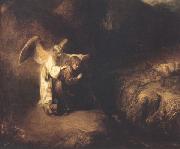 |
Willem Drost
|
|
Dutch Baroque Era Painter, ca.1630-1680
Dutch painter, draughtsman and printmaker, possibly of German origin. According to Houbraken, he was a pupil of Rembrandt, possibly in or shortly before 1650. An early etching signed w drost 1652 is probably a self-portrait, in which Drost portrayed himself as a young man drawing. His earliest dated paintings are two pendants of 1653: the Portrait of a Man (New York, Met.) and the Portrait of a Woman .
|
|
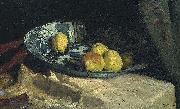 |
Willem de Zwart
|
|
(16 May 1862 The Hague - 11 December 1931 The Hague) was a Dutch painter, engraver, watercolorist, with many connections to the Hague School.
Willem De Zwart was born in The Hague on 16 May 1862, the eldest of eight children. His youngest brother, Pieter, would also become a painter. His father painted carriages for a living, and in 1875 the fourteen-year-old Willem was apprenticed to a carriage maker to learn the same trade. In his spare time, he copied prints he found in magazines, and a year later he enrolled in the evening class at the Royal Academy of Visual Art in The Hague. The following year, he was admitted at the studio of Jacob Maris. In the three years that he remained here, it is probable that he got to know many of the leading lights of the Hague School. Maris also sent De Zwart on a journey to the coast, without drawing materials, and had him work out his impressions directly on canvas when he returned to the studio.
De Zwart made several copies of works by 16th and 17th century masters in the Mauritshuis. He was most interested in the works of Johannes Vermeer, Paulus Potter, and Rembrandt, but studied paintings by German and Italian masters, as well. Sometimes he produced copies on commission. In this period, he also made detailed studies of animals, concentrating particularly on their legs, heads and snouts. De Zwart developed a fastidious painting style with a sober, predominantly brown palette.
Willem de Zwart lived and worked until 1894 in The Hague and from 1900 to 1905 in Amsterdam. His work has a wide range of subjects: landscapes, cityscapes, portraits and still life, rendered in a naturalistic or impressionist style. His work shows affinity with the people and city-oriented Amsterdam Impressionism. In his choice of subjects belonged to the Hague School and in his style and his exuberant use of color to the school of Amsterdam Impressionism. He is also known as the "Hague Breitner" because of the similarity of his work to that of George Hendrik Breitner. He painted his landscapes, figure paintings and still lifes with smooth, bold brushstrokes. De Zwart applied the paint thickly, sometimes straight from the tube, with bright colors, exuberant reds, yellows and blues, giving his paintings special vibrancy.
|
|
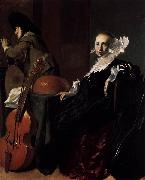 |
Willem Cornelisz. Duyster
|
|
(1599-1635) was a Dutch Golden Age painter from Amsterdam.
According to the RKD, his name was taken from his house on the Amsterdam Koningstraat, which was called "De Duystere Werelt", the dim world. He was a pupil of Pieter Codde. He married the sister of the painter Simon Kick (1603-1652), who himself married Willem's sister.
|
|
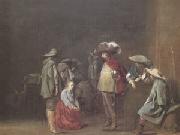 |
Willem Cornelisz Duyster
|
|
Willem Cornelisz Duyster (1599 ?C 1635) was a Dutch painter from Amsterdam.
Duyster paintings generally depicted genre scenes and portraits, quite often of soldiers. He exhibited a strong ability to paint textiles, accurately characterize his subjects, and to depict relationships between his figures. Duyster career was cut short when he succumbed to the plague in 1635.
|
|
 |
Willem Drost
|
|
Dutch Baroque Era Painter, ca.1630-1680
Dutch painter, draughtsman and printmaker, possibly of German origin. According to Houbraken, he was a pupil of Rembrandt, possibly in or shortly before 1650. An early etching signed w drost 1652 is probably a self-portrait, in which Drost portrayed himself as a young man drawing. His earliest dated paintings are two pendants of 1653: the Portrait of a Man (New York, Met.) and the Portrait of a Woman (The Hague, Mus. Bredius). The man portrait is signed Wilhelmus Drost F. Amsterdam 1653; the form of the first name implies that he was of German descent.
|
|
|
|
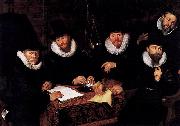 |
Werner van den Valckert
|
|
Though he was born in Amsterdam, he became a member of the Guild of St. Luke in the Hague between 1600 - 1605. By 1614 he had moved to Amsterdam, because his daughter was baptized there. His earliest dated etchings are from 1612. His surviving paintings are historical allegories and portraits. He also made a prestigious schutterstuk, which features the Amsterdam burgermeester Albert Burgh.
According to Houbraken, he was a student of Hendrik Goltzius. He painted a series of 4 paintings showing a doctor as angel, Christ, a man, and the devil; these were all based on engravings by Goltzius. These paintings are now in the possession of the Boerhaave Museum, which has other similar series on display.
|
|
|
|
|
|
|
|
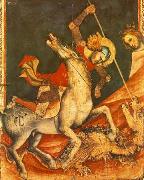 |
VITALE DA BOLOGNA
|
|
Italian Gothic Era Painter ,
b. 1289/1309, Bologna, d. 1359/69, Bologna
|
|
|
|
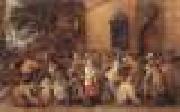 |
VINCKBOONS, David
|
|
Flemish Baroque Era Painter, 1576-ca.1632
was a Dutch painter of Flemish origin. Vinckboons was one of the most prolific and popular painters and print designers in the Netherlands. Himself influenced by Pieter Bruegel the Elder, he was instrumental ?? together with Hans Bol and Roelant Savery ?? in the development of genre painting in the northern Netherlands. The family moved to Antwerp around 1580, and then to Middelburg after the Spanish occupation of Antwerp in 1585. It is not likely they moved for religious reasons to Amsterdam. His father became a citizen in 1591, but none of his grandchildren were baptized in a Calvinist church. In 1602 David married in Leeuwarden to Agneta van Loon, the daughter of a notary. Then he lived in Sint Antoniesbreestraat like many other artists and painters. According to Karel van Mander he did not have any teacher other than his father Phillipe, a painter on canvas with watercolors, an art form practised mainly in his birthplace of Mechelen. David specialized in elegant figures in park-like landscapes (Outdoor Merry Company, 1610; Vienna, Akademie der Bildenden K??nste) as well as Kermis and other village festivals. His landscapes reflect his contact with Gillis van Coninxloo. Vinckboons attracted a number of students; among them were Gillis d'Hondecoeter, Claes Janszoon Visscher and probably Esaias van de Velde. Vingboons, as his name is often spelled,
|
|
|
|
|
|
|
|
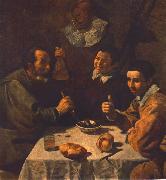 |
VELAZQUEZ, Diego Rodriguez de Silva y
|
|
Spanish Baroque Era Painter, 1599-1660
Spanish painter. He was one of the most important European artists of the 17th century, spending his career from 1623 in the service of Philip IV of Spain. His early canvases comprised bodegones and religious paintings, but as a court artist he was largely occupied in executing portraits, while also producing some historical, mythological and further religious works. His painting was deeply affected by the work of Rubens and by Venetian artists, especially Titian, as well as by the experience of two trips (1629-31 and 1649-51) to Italy. Under these joint influences he developed a uniquely personal style characterized by very loose, expressive brushwork.
|
|
|
|
|
|
|
|
|
|
|
|
|
|
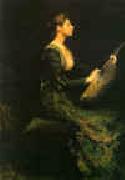 |
Thomas Wilmer Dewing
|
|
1851-1938
Thomas Wilmer Dewing Gallery
was an American painter working at the turn of the 20th century. He was born in Newton Lower Falls, Massachusetts. He studied at the Acad??mie Julian in Paris, and later settled into a studio in New York City. He married Maria Oakey Dewing, an accomplished painter with extensive formal art training and familial links with the art world.
He is best known for his tonalist paintings, a sub-genre of American art that was rooted in English Aestheticism. Dewing's preferred vehicle of artistic expression is the female figure. Often seated playing instruments, writing letters, or engaged in other impassive actions and situated in gauzy, dreamy interiors, the figures remain remote and distant to the viewer. These scenes are infused with a color that pervades the entire picture, setting tone and mood. The ethereal delicacy and subtle color harmonies of Dewing's paintings have not met with universal approval: some feminist critics have lambasted Dewing's work as being misogynistic; he rarely painted anything other than the female figure, vacant of expression, languishing in sumptuous clothing.
Tonalism quickly came to be considered outdated with the advent of modernism and abstraction in art, though Dewing was successful in his own day. His art was considered extremely elegant, and has undergone a subtle revival in the last 10 years or so.
Dewing was a member of the Ten American Painters, a group of American Impressionists who seceded from the Society of American Artists in 1897.
He spent his summers at the art colony in Cornish, New Hampshire.
|
|
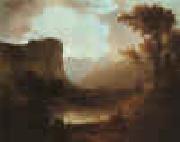 |
Thomas Doughty
|
|
1793-1856
Thomas Doughty (July 19, 1793 ?C July 22, 1856) was an American artist of the Hudson River School.
"Gilpin's Mill on the Brandywine" attributed to Thomas Doughty circa 1827Born in Philadelphia, Thomas Doughty was the first American artist to work exclusively as a landscapist and was successful both for his skill and the fact that Americans were turning their interest to landscape. He was known for his quiet, often atmospheric landscapes of the rivers and mountains of Pennsylvania, New York, New England, and especially the Hudson River Valley. He taught himself how to paint while aprenticing for a leather manufacturer.
|
|
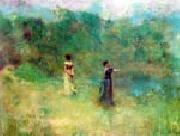 |
Thomas Dewing
|
|
(May 4, 1851 C November 5, 1938) was an American painter working at the turn of the 20th century. He was born in Newton Lower Falls, Massachusetts. He studied at the Acad??mie Julian in Paris, and later settled into a studio in New York City. He married Maria Oakey Dewing, an accomplished painter with extensive formal art training and familial links with the art world.
He is best known for his tonalist paintings, a sub-genre of American art that was rooted in English Aestheticism. Dewing's preferred vehicle of artistic expression is the female figure. Often seated playing instruments, writing letters, or engaged in other impassive actions and situated in gauzy, dreamy interiors, the figures remain remote and distant to the viewer. These scenes are infused with a color that pervades the entire picture, setting tone and mood. The ethereal delicacy and subtle color harmonies of Dewing's paintings have not met with universal approval: some feminist critics have lambasted Dewing's work as being misogynistic; he rarely painted anything other than the female figure, vacant of expression, languishing in sumptuous clothing.
Tonalism quickly came to be considered outdated with the advent of modernism and abstraction in art, though Dewing was successful in his own day. His art was considered extremely elegant, and has undergone a subtle revival in the last 10 years or so.
Dewing was a member of the Ten American Painters, a group of American Impressionists who seceded from the Society of American Artists in 1897.
|
|
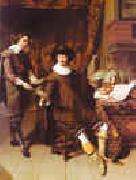 |
Thomas De Keyser
|
|
1586-1667
Dutch
Thomas De Keyser Gallery
De Keyser excelled as a portrait painter, and was the most in-demand portrait painter in the Netherlands until the 1630s, when Rembrandt eclipsed him in popularity. Rembrandt was influenced by his work, and many of de Keyser's paintings were later falsely attributed to Rembrandt.
His portraiture is full of character and masterly in handling, and often distinguished by a rich golden glow of color and Rembrandtesque chiaroscuro. Some of his portraits are life-size, but the artist generally preferred to keep them on a considerably smaller scale, like the famous Four Amsterdam burgomasters assembled to receive Marie de Medici in 1638, now on display at the Mauritshuis museum in The Hague.
In addition to portraits, he also executed some historical and mythological pictures, such as the Theseus and Ariadne in the Amsterdam town hall, now the Royal Palace. De Keyser also worked as an architect. From 1662 until his death in 1667 he oversaw construction of the new Amsterdam town hall, now Royal Palace.
De Keyser was a son of the architect and sculptor Hendrik de Keyser. We have no definite knowledge of his training, and but scant information as to the course of his life. Aert Pietersz, Cornelis vander Voort, Werner van Valckert and Nicolas Elias are accredited by different authorities with having developed his talent.
In the 1640s, de Keyser received very few painting commissions, and was forced to seek income elsewhere. He owned a basalt business from 1640 until 1654, when he returned to painting.
The Rijksmuseum in Amsterdam has the largest collection of paintings by de Keyser. His work can also be seen at the Louvre in Paris, the Metropolitan Museum of Art in New York City, the Hermitage in Saint Petersburg and the National Gallery in London, among others.
The Stedelijk Museum modern art museum in Amsterdam carries a statue of de Keyser on its facade. A street in Enschede is named for him.
A contemporary namesake of the painter was Thomas de Keyser (Utrecht, 1597-1651), an actor and nephew of Hendrick de Keyser.
|
|
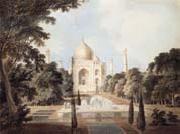 |
Thomas Daniell
|
|
1749-1840,was an English landscape painter. He was born at the Chertsey inn, kept by his father, in 1749, and apprenticed to an heraldic painter. Daniell, however, was animated with a love of the romantic and beautiful in architecture and nature. Up to 1784 he painted topographical subjects and flower pieces. By this time his two nephews had come under his influence, the younger, Samuel, being apprenticed to Medland the landscape engraver, and the elder, William, being under his own care. In this year (1784) he embarked for India accompanied by William Daniell, and found at Calcutta ample encouragement. Here he remained ten years, and on returning to London he published his largest work, Oriental Scenery, in six large volumes, not completed till 1808. From 1795 until 1828 he continued to exhibit Eastern subjects, temples, jungle hunts, &c., and at the same time continued the publication of illustrated works. These are Views of Calcutta; Oriental Scenery, 144 plates; Views in Egypt; Excavations at Ellora; Picturesque Voyage to China. These were for the most part executed in aquatint.
|
|
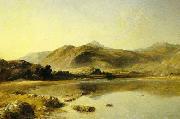 |
Thomas Danby
|
|
(c. 1818 - 25 March 1886) was an English landscape painter.
Danby was born, it is thought, in Bristol in south-west England, the younger son of Francis Danby (1793-1861). He had an elder brother, James Francis Danby (1816-75) who also became a landscape painter. Thomas went with his father to Europe in 1829, living for a time in Paris where he was able to earn a living by copying pictures at the Louvre in Paris. He thus became an earnest admireer and "student" of Claude Lorrain, whose aerial effects he sought to imitate.
Returning to England about the same time as his father, he first exhibited at the British Institution in 1841, and afterwards frequently at the Royal Academy from 1843. He was a friend of Paul Falconer Poole, with whom he shared a house in Hampstead in 1843, and imbibed not a little of his romantic feeling for nature. From 1855 to his death, Danby resided in or near Hampstead in north London..
The subjects of his landscapes were usually taken from Welsh scenery, especially the old county of Merioneth; his pictures for the most part were not ideal compositions (unlike his father's work) but actual scenes pervaded with a true romantic spirit. "He was always trying" says the writer of his obituary in The Times newspaper, "to render his inner heart's feeling of a beautiful view rather than the local facts received on the retina."
He came, it is said, within one vote of election as an Associate of the Royal Academy (ARA) but, failing eventually to attain Academy honours, he devoted himself in his latter years chiefly to watercolour painting. He became a member of the Royal Hibernian Academy in 1860, an associate of the Society of Painters in Watercolours in 1867, and a full member of the latter in 1870; until his death his contributions were prominent amongst the works at the society's exhibitions.
Danby died of a chest complaint, terminating in dropsy on 25 March 1886. He had been twice married, and had 2 daughters and a son from the second marriage.
|
|
|
|
|
|
|
|
|
| Wholesale China Oil Painting Wholesale Oil Painting China Xiamen Portrait Reproduction on canvas Chinese Oil Painting Wholesale USA Oil Painting |
|
|
|
|
|